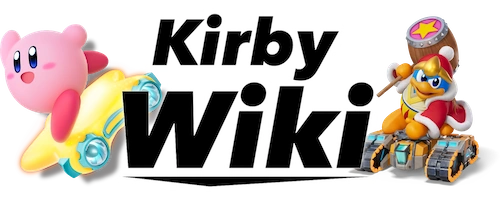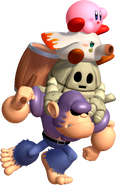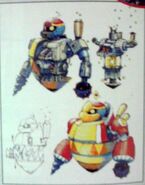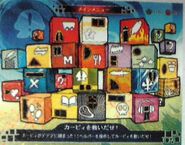| This article is about an unreleased or cancelled game | (Edit | (Similar) |
| Information is likely to be incomplete, and may be self-conflicting. Added information should have verifiable sources, as otherwise it may be deleted. |
|
Kirby GCN (also referred to as Kirby: Legend of the Stars and Kirby Adventure) is the common unofficial title referring to any of the three 3D Kirby titles for the Nintendo GameCube that were silently cancelled; of the three, only the first incarnation was widely documented.
Nintendo had not released any further info about this game's status for a long period of time, as well as having removed the game's page from their website. There had been conflicting reports on whether the game had ceased development or if it had shifted to the Wii or DS - it was speculated to have even been replaced by another game such as Kirby Super Star Ultra.
Some aspects of each of the three individual developments carried over into Kirby's Return to Dream Land, and it wasn't until the release of Kirby's Dream Collection Special Edition that it was revealed that Kirby's Return to Dream Land was the successor to Kirby GCN. Also, some of the elements, like befriending three enemies at once and stacking with each other, were later used by Kirby Star Allies.
Story
All that was revealed about the original storyline is that King Dedede stole Kirby's Warp Star and he is trying to get it back. The story bears no similarity to the story in Kirby's Return to Dream Land or Kirby Star Allies, which instead featured aspects of the GameCube game's gameplay.
Gameplay
The original version of the game in development featured a variation of the Helper System from Kirby Super Star. In Kirby GCN, up to three Helpers could be created at once. They could then be controlled by up to three players or by the computer. It is possible that the game had a 3D playing field. A stacking system had also been revealed where Kirby and his Helpers could ride on each other's backs (possibly creating new attacks). Looking at screenshots, it is discernible that the Helpers created by the player would have been yellow, green, or blue color variations of their respective enemies. These color variations would have denoted different players. Presumably, yellow denoted Player 2, blue denoted Player 3, and green denoted Player 4. These exact colors were later used to denote multiple Kirbys in Kirby's Return to Dream Land, and were once again used to represent befriended enemies in Kirby Star Allies.
Copy Abilities
A total of 16 Copy Abilities were known to have appeared in this game, but it's likely more were planned to appear during development. Some abilities would have had updated designs, a feature that was passed on to Kirby's Return to Dream Land.
- Beam
- Bomb
- Cleaning
- Cutter
- Fighter
- Fire
- Hammer
- Ice
- Parasol
- Plasma
- Stone
- Sword
- Tornado
- Water and/or Bubble
- Wheel
- Wing
Helpers
- Waddle Doo
- Blade Knight
- Bonkers
- Golem
- Broom Hatter
- Unnamed Tornado enemy
- Unnamed Bomb enemy
- Unnamed Water/Bubble enemy that looks similar to Pluid
- Chilly
- Flappy
- Parasol Waddle Dee
- Sir Kibble
- Wheelie
- Heat Phanphan
- Plasma Wisp
- Knuckle Joe
Piggyback Helpers
Non-Copy Ability Enemies
Bosses
- Whispy Woods
- HR-D3
- Shipwreck Octopus
- Morpho Knight
- Unnamed Final Boss
Trivia
- The large robot resembling King Dedede (later named HR-D3) that Kirby was seen fighting against in the trailer makes a surprise appearance in Kirby Mass Attack, at the end of Chapter 2 in Kirby Quest. It is possible that its appearance was meant as foreshadowing, but it was more than likely a nod to the 2005 trailer. It also makes an appearance in Kirby's Return to Dream Land, but in a nearly complete red facade and a Metal General EX-Logo on its chest in place of the King Dedede-Logo.
- Many of the screenshots, especially the Plasma one, indicate that this game may have been a 2.5D game in the vein of Kirby 64: The Crystal Shards, instead of Kirby's Return to Dream Land's 2D gameplay.
- In the trailer, Kirby's 3D model appears to be the same one used in Kirby Air Ride.
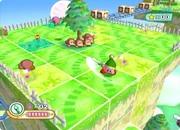
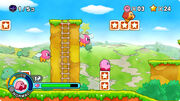
- The Kirby GCN game that was shown off at E3 2005 was actually one of three lost Kirby games, all completely built from the ground up. Eleven years were spent creating and abandoning these games.[1]
- The second Kirby GCN game would have been the first Kirby game in the main series that was a 3D platformer. It was canceled because it hadn't reached the quality Nintendo was expecting.
- The third Kirby GCN game involved an animated 2D Kirby in a pop-up book setting. Copy Abilities were renewed and could be powered up.
- The music that played in the trailer is reused in Kirby's Return to Dream Land's The Arena and The True Arena. Its official name on the soundtrack is "Road to Victory". The song was used again in Kirby: Triple Deluxe in the second extra stage of Royal Road. A remix of the music can also be heard in Kirby Star Allies in puzzle rooms of levels in Far-Flung - Starlight Heroes. A piano version can be heard in the same game in the Dream Palace.
- Kirby 3D Rumble, a sub-game in Kirby: Planet Robobot, Kirby's Blowout Blast, and Kirby Battle Royale appear to be greatly inspired by the second Kirby GCN game.
- Kirby Star Allies shows similarities to the Kirby GCN game shown at E3 2005; a resemblance is made more striking due to the appearance of the returning Cleaning, Plasma, and Water abilities, with Plasma resembling its appearance in Kirby Air Ride, and the return of both Helpers and the four-player co-op.
- Kirby Star Allies uses all of the helper-related gameplay of Kirby GCN, including the different colored helpers/friends.
- In a Nintendo Dream interview with Shinya Kumazaki, the design for Morpho Knight was planned to appear in this game.[2] Its design remains unaltered in Kirby Star Allies, though its sword slightly differs.
- In the files for Kirby's Return to Dream Land, there is unused music that uses the same music found in the game, but with an older soundfont. The soundfont used is reminiscent to the default one used for the Nintendo 64 and GameCube consoles, possibly meaning that Kirby GCN had similar music to its successor.
- The concept for King Dedede's Jet Hammer may have come from this game according to concept art, though it wouldn't make its appearance until Super Smash Bros. Brawl as one of King Dedede's special-moves.
